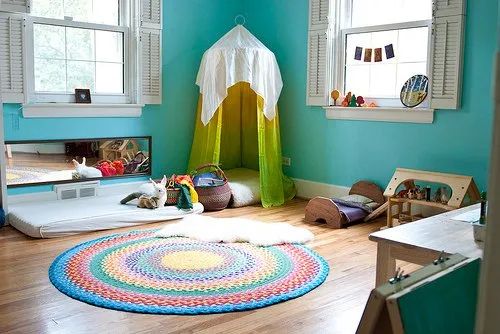
I am now just 3 months away from “B” day (Baby’s arrival), and the preparations for our little monkey (that’s his name for now) are in full swing. As I began the process, I first jumped onto the pop-culture train of registering at a large chain store and thinking about what colors or “theme” I wanted to decorate the nursery. Then I had an awakening to the Montessori way of preparing for baby. Thanks to my completion of the Montessori Online Training for Parents, I was aware that my baby needs more than a theme in the nursery. He actually needs a prepared environment that will help him to feel safe, secure, and able to explore and learn through touch. So, I ditched the focus on the decorations, and instead turned to the real content: the environment and the child. I turned my attention to…
1. Think outside the nursery. The first thing I realized, from the Montessori perspective, is that a child needs to have his entire environment comfortable to explore through touch and movement. So, the nursery shouldn’t be the only space that gets prepared. I focused on seeking ways to childproof the kitchen, living room, play room, and nursery, so that little monkey can move around with ease once he starts reaching and crawling and toddling. Among other things, this includes anchoring bookshelves that could otherwise get pulled over, having toys in baskets on low shelves, and keeping the number of toys to a minimum, so baby can see what is available without being overwhelmed by clutter.
2. Consider toys and decorations that will match a child’s developmental needs.
 http://sewliberated.typepad.com/sew_liberated/2011/01/finnian-and-lachlans-studio.html
http://sewliberated.typepad.com/sew_liberated/2011/01/finnian-and-lachlans-studio.html

There are many toys that playmusic when you touch a button, but there are so many other ways to encourage a child’s brain. For instance a few different textured balls can provide stimulation of the brain cells as baby feels their different textures, gives a real object for the internal concept of round, and are great motivators to get baby moving when they roll away.
A second idea is to have a low hanging mirror and pull-up bar, as well as art at baby’s eye level. The mirror and pull-up bar help encourage the child’s motor development as they are able to watch their body move, and pull up on the bar. Lastly, there are several infant/toddler puzzles and blocks that help baby to learn shapes, sizes, colors, and the foundations for numbers.
3. Foster independence and free exploration wherever possible. This was the most mind-blowing for me because my research found that one of the best ways to do this is to use a “floor bed” instead of a crib. The idea is that a floor bed enables a 6-12 month old to be able to move out of the bed when they are awake in the morning, and begin playing in the environment (a well prepared and child-proofed environment of course), without having to cry for mom or dad. This works by usually having a baby gate on the door of the room, so your little one won’t wander down the stairs or somewhere unsafe. There are several great blogs that share more about why and how to use a floor bed and other aspects to create a toddler room that is great for exploring: Sew Liberated: Toddler room, Sew Liberated: Playroom.
4. Remember to look within. I realized in the midst of looking at all the things I wanted for baby that I was forgetting this precious life that is already with me, inside me. Mary Ellen Maunz has a great webinar named “10 Gifts for Your Unborn Child” that highlights how babies are affected by smells, songs, the stress of a mother, and so much more in utero. Montessori was famous for saying that education begins “9 months before the child is born”. So I have made time during the end of my pregnancy to pause and talk to my baby, sing songs, and relax as ways to connect with my baby and encourage his neurodevelopment in utero.
Consider taking this rich short-course that provides an excellent
foundation for Montessori Teachers and Parents!






















